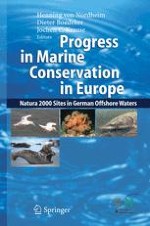2006 | OriginalPaper | Buchkapitel
Rationale behind site selection for the NATURA 2000 network in the German EEZ
verfasst von : Dr. Jochen C. Krause, Dieter Boedeker, Ina Backhausen, Kathrin Heinicke, Annette Groß, Dr. Henning von Nordheim
Erschienen in: Progress in Marine Conservation in Europe
Verlag: Springer Berlin Heidelberg
Aktivieren Sie unsere intelligente Suche, um passende Fachinhalte oder Patente zu finden.
Wählen Sie Textabschnitte aus um mit Künstlicher Intelligenz passenden Patente zu finden. powered by
Markieren Sie Textabschnitte, um KI-gestützt weitere passende Inhalte zu finden. powered by
In the offshore waters of the European Seas, the selection of NATURA 2000 sites has only recently started. The guidelines for this process are still being developed by a Marine Expert Working Group under the umbrella of the European Commission. In 2002, following the adoption of the new German Federal Nature Conservation Act (Bundesnaturschutzgesetz), a relevant survey programme of the German Federal Ministry for Environment, Nature Conservation and Nuclear Safety and the German Federal Agency for Nature Conservation with the title
HabitatMareNATURA2000
started. Its purpose was to identify, locate and assess Annex I habitats and Annex II species of the Habitats Directive (92/43/EEC), and Annex I-bird species as well as regularly occurring migratory birds of the Birds Directive (79/409/EEC) in the offshore area of the German North Sea and Baltic Sea. The present chapter outlines how scientific conclusions (summarised in the more technical chapters of parts III and IV of this book) were used for this task in the German Exclusive Economic Zone (EEZ). For habitats and species, the selection process itself was performed according to the criteria given in Annex III (so-called stage I criteria) of the Habitats Directive and according to Article 4 of the Birds Directive, respectively. As a result of this programme, Germany nominated to the European Commission in 2004 a comprehensive set of ten new marine NATURA 2000 sites in the German EEZ of the North Sea and the Baltic Sea: eight under the Habitats Directive and two under the Birds Directive. It was the first Member State to do so. Short descriptions of the habitats and species of each site are given in this chapter. In total, 31.5% (1,040,783 hectares) of the German EEZ is now covered by NATURA 2000 sites. This shows that despite many commonly recognised obstacles (i.e., limited information on sea-bottom habitats and communities, or missing necessary scientific research programmes to fill knowledge gaps), it was possible to select and nominate sites in offshore areas which fulfil the quality objectives of the European Nature Directives. However, the overall conservation value of the selected Marine Protected Areas (MPAs) within the EU still depends on the collective efforts of all Member States and, particularly, on the implementation of effective management plans.
